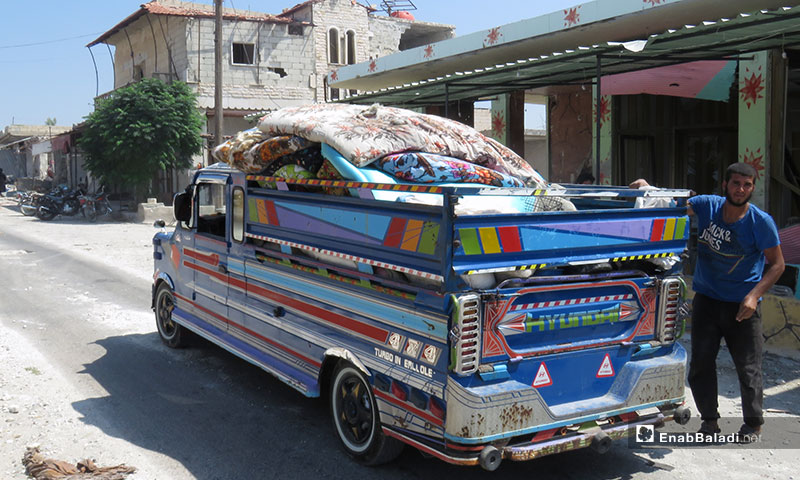



Even after Russian Defense Ministry announced a ceasefire in southern Idlib countryside on August 31, displaced families did not fully trust the truce will remain sustainable so they can return to their areas that have become relatively quiet after being hit by heavy shelling for four months. However, some took advantage of the ceasefire to return and bring their belongings, for they were unable to carry them when they were displaced under the shelling.
The population seemed cautious about returning in order to avoid the scenario of the previous agreement, when the guarantor countries announced a truce in Idlib in early August during the Astana talks. However, the truce did not last more than three days when the Syrian regime announced suspending it, accusing the opposition factions of violating the agreement.
Humanitarian organizations have been talking about some people returning to their areas in the southern countryside of Idlib. The majority of returnees took advantage of the ceasefire to move their belongings and furniture to their areas of displacement. They did not return to settle down, because of the constant artillery and rocket shelling and airstrikes.
Badie al-Issa, a citizen of the town of Kafrsajna in Maarat al-Numan in southern Idlib countryside, confirms to Enab Baladi the difficulty of returning to his town and settling again, because of the shelling.
“The town of Kafrsajna is being targeted by the regime’s bombardment on a daily basis, putting our lives at risk. In addition, the town lacks the basic necessities of a decent life as there are no doctors, nurses, pharmacies or shops, and even water supplies are disrupted.”
Badie said that the truce Russia has declared was “false”, as the shelling did not stop in the town for months, but rather became less intense than before. Surveillance planes were flying over the town, which buildings and streets have become destroyed, he said.
Nonetheless, Badie said the truce allowed him, and other residents, to re-enter during quiet times and take out some of the remaining household furniture, noting that they would sell this furniture in order to secure money for winter.
Ali Maqsous, a resident of the town of Maar Tahroma, south of Idlib, told Enab Baladi that when Russia announced a ceasefire, he rushed since the early morning to enter the town and take the remaining house furniture, clothes, and other necessities. He immediately left fearing the shelling, or the Syrian regime forces storming the town, as happened in many cities and towns in the northern countryside of Hama.
Referring to the reason why he did not return and settle there after declaring a ceasefire, Ali, who is living with his family in the camps in northern Syria, said: “In practice, the shelling did not stop in the town of Maar Tahroma. Artillery and rocket-propelled grenades are heaping on the town on a daily basis. Also, reconnaissance aircraft always fly in the sky.” He added: “All these things discouraged me from returning.”
Moataz Abu Yazid, Director of the Syrian Civil Defense in the town of Maar Tahroma, confirmed to Enab Baladi that after announcing the first truce, on August 2, a large part of the people in the southern countryside of Idlib returned to their homes, but the Syrian regime breaching the agreement and Russia breaking the truce pushed people to move again.
Due to their previous experience of return, people are now afraid to come back to their cities and towns during the second “formal” truce, Russia has announced on August 31, especially since the artillery and rocket shelling on most areas of the southern countryside of Idlib did not stop, according to Abu Yazid. People in these areas remain displaced in the camps in northern Syria.
The Director of the Syrian Civil Defense in Maar Tahroma documented the shelling on the towns and villages there since the announcement of the second truce until September 13. Those areas were subject to more than 132 artillery shells fired from the regime’s checkpoints in al-Hubait. These attacks targeted villages and towns of Maar Tahroma, Maar Tamater, Jbala, Maarzita, Sheikh Mustafa and Umm al-Seer Araynabah, Naqir, Maarat Assin, Tramla, al-Figaa, Karsaa, and Tel Aas.
According to the Syria Response Coordinators, 13,671 civilians have returned to their villages in the southern countryside of Idlib from August 31 to September 6 as a result of the relative calm in these areas.
if you think the article contain wrong information or you have additional details Send Correction